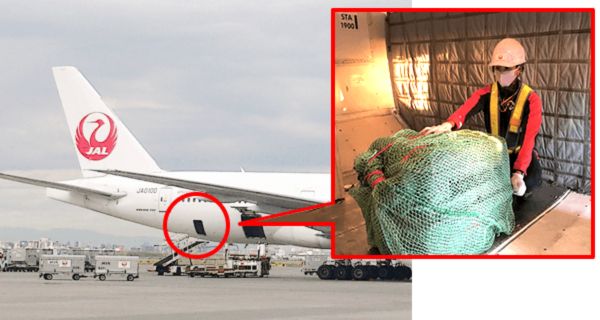Japan Airlines Pet Policy
Japan Airlines’ pet policy allows you to transport certain pets as checked baggage or cargo baggage on domestic and international flights. Pets are not allowed in the passenger cabin. However, Certified Service Animals such as guide/assistance dogs are allowed to accompany their owners free of charge in the passenger cabin.
Japan Airlines Pet Policy—Pets in the Cabin
What is Japan Airlines’ pet policy for in-cabin pets?
Japan Airlines does not accept pets in the passenger cabin. However, Certified Service Animals (dogs) can travel free of charge in the passenger cabin with passengers who are solely dependent on them for mobility/assistance.
Passengers travelling with service animals must notify Japan Airlines in advance and:
- Present a training certificate proving that the dog has received special training.
- Ensure that the dog remains at the owner’s feet during the entire flight.
- Ensure that the dog wears a cape/vest indicating that it is an assistance dog.
- Carry a muzzle and use it when required.
- Ensure that they do not feed the dog anything other than water.
There’s no pet fee for Certified Service Animals.
Japan Airlines Pet Policy for International Flights—Pets as Checked Baggage
What is Japan Airlines’ international pet policy for pets as checked baggage?
Japan Airlines’ pet policy for international flights allows you to travel with certain domestic pets as checked baggage in the cargo section of the aircraft. This means your pet will be travelling on the same flight as yours—but not with you in the passenger cabin. After arrival, your pet will be handed over to you in the baggage claim area.
- Pets Allowed. Cats, dogs (except French Bulldogs and Bulldogs), small birds that feed on seeds, fruit and insects, ferrets, hamsters, rabbits, squirrels, chinchillas, and marmots.
- Pet Age. Cats and dogs must be at least 8 weeks old to travel.
- Pet Reservations
- Book in advance to ensure space availability—JAL may take several days to confirm space availability.
- Call Japan Airlines at + or the JAL office in your city/country.
- Be ready with the following information when making a reservation:
- Size of the pet crate, i.e., length, width, and height
- Total weight of the pet and crate
- Type of crate
- Your pet’s age on the date of travel
- JAL will notify you whether your pet can be accommodated—and this can take several days.
- Number of Pet Crates Allowed. Will vary by aircraft type.
- Pet Documents
- You must obtain the documents per quarantine regulations of the exporting and importing countries.
- Valid health certificate issued by a certified vet within 10 days of departure.
- Sign the documentation required by JAL at the departure airport.
- If you’re travelling with a pet to the United States, remember that the Centers for Disease Control and Prevention (CDC) has placed a temporary ban on the entry of dogs from high-risk rabies countries from July 14, 2021. This means if your dog has visited a high-risk rabies country in the last 6 months, it will not be allowed to enter the United States.
- Pet Crate Requirements
When travelling with a pet on Japan Airlines, your pet crate must meet the following conditions:- The pet crate must be spacious enough for your pet to stand up, turn around, and lie down.
- The pet crate must be made of durable fiberglass, wood, plastic, or other material of similar strength.
- The pet crate must be properly ventilated.
- Pet crates made entirely out of wire/welded mesh (except the bottom) are not recommended.
- The pet crate must be leakproof, escape-proof, and lockable.
- If you’re transporting rodents and animals with strong teeth—such as hamsters, rabbits, etc.—you must arrange an appropriately designed pet carrier that is fully enclosed with a wire mesh to prevent them from escaping.
- Only one pet per crate is allowed.
- For assistance or more information, call Japan Airlines at or the JAL office in your city/country.
- Pet Precautions
- At check-in
- Feed and water your pet properly before check-in.
- Place a durable, watertight water bottle inside the crate (plus food if required), as your pet will not be provided water or food after it is checked in.
- Reach the airport at least 2 hours before departure so that your pet can adapt to the local temperature.
- During Summer and Winter
- Avoid travelling with your pet in the summer months (May, 1 – October, 31) due to heat and humidity, especially pups, elderly dogs, and Brachycephalic (snub-nosed) breeds.
- Exercise caution when transporting your pet during severe winter, especially if it is sensitive to cold.
- Air Pressure/Lighting
- The air pressure in the bulk cargo section of the aircraft is 0.8 bar, which is approximately the pressure your pet would feel on a 2000-meter mountain top. When ascending or descending, the change of pressure may cause your pet to experience airplane ear or other reactions.
- The temperature and humidity in the bulk cargo room (air-conditioned) are the same as that inside the passenger cabin.
- The lighting is turned off inside the bulk cargo room during a flight.
- At check-in
- Pet Restrictions
- Pregnant or sick pets will not be accepted.
- Pets with offensive odors will not be accepted.
- The following Brachycephalic (snub-nosed) dog breeds will not be accepted on international flights:
- Tibetan Prayer Dog
- Staffordshire Bull Terrier
- Shih Tzu
- Shar Pei
- Pug
- Pit Bull Terrier
- Perro de Presa Canario
- Mastiff Pekinese
- Lhasa Apso
- King Charles Spaniel
- Italian Corso dog
- Chow Chow
- Chin
- Cavalier King Charles Spaniel
- Bull Terrier
- Brussels Griffon
- Boxer
- Boston Terrier
- Bordeaux Mastiff
- Affenpinscher
Tips on Transporting Pets on Japan Airlines International Flights as Checked Baggage
Before departure
- Review the import and export rules
The rules vary by country, so contact the embassy, consulate, or quarantine office of the departure and arrival countries to ensure you have the correct documentation, such as health certificate, import/export permit, export quarantine certificate, and import certificate. If your country of departure requires an export quarantine examination, do complete it before going to the check-in counter. If it is required at an airport in Japan, be sure to visit during office hours. For more information, refer to animal quarantine information.
- Prepare a Letter of Consent
You will need to prepare a Letter of Consent confirming that you agree to check in your pet as baggage. Be sure to bring it to the airport check-in counter on the day of travel.
- Check in your pet
Be sure to check in your pet at least 2 hours before your flight’s scheduled departure time. minutes in advance.- You can check in your pet at the same check-in counter as yours.
- Present your pet’s paperwork at the check-in counter.
- Sign the necessary forms.
- Pay the pet fee.
Your pet will be transported to the aircraft’s bulk cargo room just before the flight takes off.


- Pick-up and handover at the arrival airport
- A JAL staff member will bring your pet to the arrival lobby from the cargo compartment and deliver it to you in the baggage claim area.
- Go to the Quarantine Station at the airport and complete the immigration procedures for your pet.
Japan Airlines Pet Policy for Domestic Flights—Pets as Checked Baggage


Japan Airlines pet policy for domestic flights within Japan is as follows:
- Pets Allowed
- Cats, dogs (except Bulldogs and French Bulldogs), hamsters, rabbits, small birds, and other small animals can travel as checked baggage.
- Turtles, insects, and goldfish, turtles and insects are allowed onboard as long as they don’t disturb other passengers.
- Pet Weight
- The total weight of the pet (plus crate) must not exceed 70lb/32kg—but the weight limit for flights operated by JAC/HAC and RAC is 99lb/45kg.
- If the total weight of the pet (incl. crate) exceeds 70lb/32kg, it will be checked in as cargo baggage and not checked baggage.
- Pet Crate Requirements. You’re allowed to use your own crate or rent a pet crate provided by JAL.
Tips on Transporting Pets on Domestic Flights as Checked Baggage
- Reach the airport early.
- Prepare a letter of consent for checking in your pet.
You can fill it out at the airport but to avoid delays, fill out the form in advance. - Check-in your pet at least 40 minutes at the Traveling with Pets service counter.
(The counter is located in the baggage check-in area).
- Submit the letter of consent.
- Pay the pet fee.
Note. Your pet will be kept at the counter and transported to the aircraft’s air-conditioned cargo hold section, known as the bulk cargo room, just before departure.
- Your pet will be handed over to you in the arrival lobby by an airport agent.
Japan Airlines Pet Fees—Pets as Checked Baggage
- Pet Fee—International Flights
- The international pet fee for pets as checked baggage will vary by route and will typically be as follows:
- ~USD/CAD 400 (¥ 40,000) per crate per flight sector on flights between Japan, India, Europe, Asia, Africa, the Middle East, North America, Hawaii, Central/South America, Oceania, and Hawaii.
- ~USD/CAD 250 (¥ 25,000) per crate per flight sector on flights between Japan and Oceania, Guam, and Asia.
- ~USD/CAD 50 (¥ 5,000) per crate per flight sector on domestic flights within Japan that are subject to international conditions of carriage.
- Pet Fee—Domestic Flights
- The domestic pet fee for pets travelling as checked baggage within Japan will range from ¥ 3,000 – 6,000 per crate per flight sector, depending on your route.
Japan Airlines Pet Policy—Pets as Cargo Baggage on International Flights


- Pets Allowed. Cats, dogs (except Brachycephalic dog breeds), small birds that feed on seeds, fruit and insects, ferrets, hamsters, rabbits, squirrels, chinchillas, and marmots.
- Pet Age. Dogs must be at least 8 weeks.
- Pet Reservations. Must be made through an air freight forwarder or JAL Cargo (+1-718-656-9801).
- Pet Documents
- Must be per the requirements of the country of destination.
- The following documents must be attached to the Air Waybill:
- Shipper’s Declaration for Live Animals
- Export Quarantine Certificate
(issued by the appropriate animal quarantine office) - Rabies Certificate (issued by a certified vet)
- Pet Crate Requirements
What are the approved pet carrier requirements at Japan Airlines?
Your shipper/forwarder will arrange a pet crate for you that meets the following requirements:- The pet crate must be large enough for your pet to turn around while standing, and sit and stand with its legs fully stretched. It must comply with IATA Live Animals Regulations (Chapter 8, Container Requirement).
- The crate length must be the pet’s body length (A) + ½ of the leg length (B).
- The crate width must be 2x the shoulder width (C).
- The crate height (D) must be such that your pet’s head does not touch the ceiling when it stands upright.
- The pet crate must be made out of strong material that is suitable for transportation.
- The pet crate must allow adequate ventilation.
- The crate’s door (lid) must be lockable from the outside.
- Crates with latches must be latched securely.
- The crate must not be damaged or structured such that the pet can escape from it.
- The following types of containers will not be accepted:
- Cardboard box containers
- Soft cases
- Plastic clothing cases
- Weak plastic containers
- Plastic containers with cardboard lids
- Containers where the upper and lower parts are secured such that your pet cannot be given water if it looks unwell.
- Pet Precautions
- At check-in
- Place a water container inside the pet crate while ensuring it doesn’t leak.
- Make sure you have fed and watered your pet adequately before check-in. Alternatively, provide enough food and water and make sure it doesn’t leak.
- Items that make your pet feel safe, such as a favorite blanket, towel, toy, etc., are generally allowed (unless they will likely harm your pet).
- Bring your pet to the departure area at least 90 minutes before departure.
- Air Pressure/Lighting
- The air pressure in the cargo compartment can rise to 0.8 psi, which is similar to the pressure atop a 2000-meter mountain. When ascending or descending, the change of pressure may cause your pet to experience airplane ear or other reactions.
- The temperature and humidity in the bulk cargo room (air-conditioned) are the same as that inside the passenger cabin.
- The lighting is turned off inside the bulk cargo room during a flight.
- At check-in
- Pet Restrictions for Pets Travelling as Cargo Baggage
- Puppies less than 8 weeks old will not be accepted.
- Brachycephalic (snub-nosed) dog breeds will not be accepted on international flights, such as:
- Tibetan Prayer Dog
- Staffordshire Bull Terrier
- Shih Tzu
- Shar Pei
- Pug
- Pit Bull Terrier
- Perro de Presa Canario
- Mastiff Pekinese
- Lhasa Apso
- King Charles Spaniel
- Italian Corso dog
- Chow Chow
- Chin
- Cavalier King Charles Spaniel
- Bull Terrier
- Brussels Griffon
- Boxer
- Boston Terrier
- Bordeaux Mastiff
- Affenpinscher
- Other Animals Not Permitted as Cargo Baggage
- Rhesus monkeys, African green monkeys, and Cynomolgus monkeys
- Wild birds
- Monkeys and dogs for experimental purposes
- Live animals legally prohibited
- Live animals placed in unsuitable crates
How Your Pet Will Be Transported as International Cargo Baggage on Japan Airlines
- Your pet will be placed indoors in an air-conditioned area before it is loaded into the aircraft.
- Your pet will be transported in a special cart to the aircraft to protect it from wind and rain.
- Your pet will be taken to the aircraft’s cargo compartment, known as Bulk Compartment, and the pet crate will be covered with a special net.
- The pet crate will be tied securely to the floor.
- Your pet will be unloaded at the arrival airport, transported to the cargo office, checked for health, etc.
- Your pet will be kept indoors in an air-conditioned area (to the extent possible) until it is picked up.
Tips for Transporting Pets as Domestic Cargo Baggage
- Check the regulations and restrictions regarding crate requirements, breed restrictions, etc.
- Book your pet in advance
- Contact the JAL Cargo Sales Office in your city/country.
- Animals will not be accepted without booking.
- Bring your pet to the JAL Cargo Sales Office.
- Reach the Cargo Sales Office early so that you can complete the required procedures at least 90 minutes before departure.
- Complete the documentation on JAL’s booking system
- Agree to the Shipper’s Declaration for Live Animals in advance.
- Make the payment
- The pet fare will be calculated based on the total weight (pet plus crate) and container size.
- The pet fare (pet cargo freight) is typically 50% more than the general fare.
Frequently Asked Questions on Japan Airlines Pet Policy
Japan Airlines’ pet acceptance rules will depend on your flight route. Pets (other than certified service animals) are not allowed in the passenger cabin. However, pets can be transported either as checked baggage or cargo baggage in the aircraft’s cargo compartment. Certified Service Animals such as guide/assistance dogs are allowed to travel for free in the aircraft cabin with their owners.
Japan Airlines accepts cats, dogs (except Brachycephalic dog breeds), small birds that feed on seeds, fruit and insects, ferrets, hamsters, rabbits, squirrels, chinchillas, and marmots.
Pet documentation will vary by country. Before travelling, you must find out the exact documentation required by contacting the consulate, embassy, quarantine office, etc., of the countries of departure and destination.
The documentation will typically include a health certificate, export quarantine certificate, import/export permits, etc. You should complete all the required documentation before travelling. Some procedures can take a few days, so prepare well in advance. Before checking in your pet, you will need to download and fill out a Letter of Consent confirming your agreement to check in your pet as baggage. You will need to bring a signed copy to the airport and submit it at the check-in counter on the day of travel. Although this letter/form is available at the airport, filling it out in advance will help prevent congestion at the check-in counter.
Latest Pages





















Leave a Reply